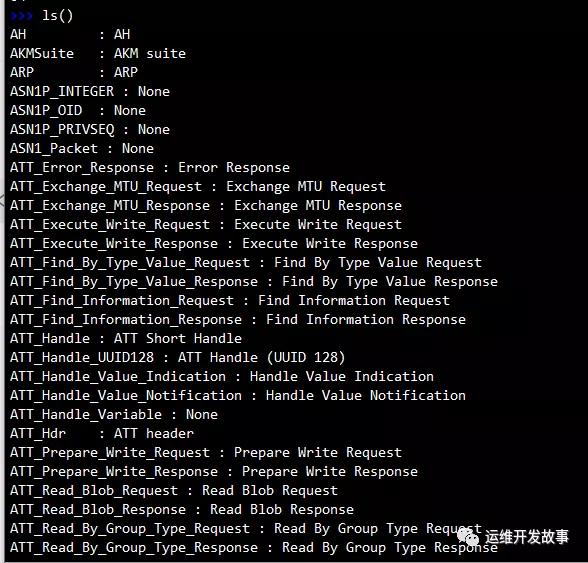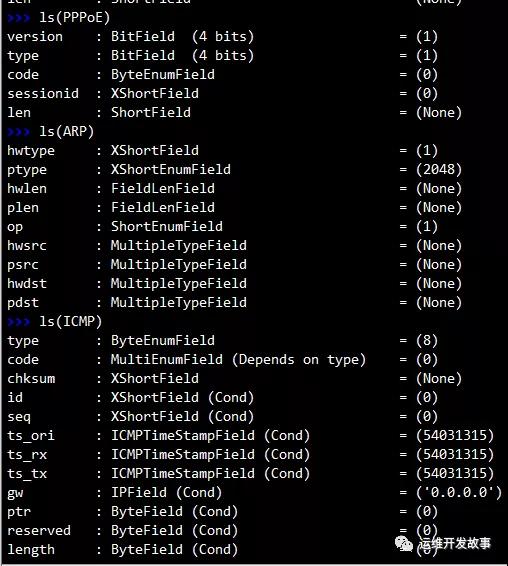數據包處理利器——Scapy基礎知識
本文轉載自微信公眾號「運維開發故事」,作者wanger。轉載本文請聯系運維開發故事公眾號。
什么 是scapy
Scapy是功能強大的交互式數據包處理程序。它能夠偽造或解碼各種協議的數據包,在線發送,捕獲,匹配請求和響應等。它可以輕松處理大多數經典任務,例如掃描,跟蹤路由,探測,單元測試,攻擊或網絡發現,它可以代替hping,arpspoof,arp-sk,arping,p0f甚至Nmap,tcpdump和tshark的某些部分。。它在其他工具無法處理的許多其他特定任務上也表現出色,例如發送無效幀,組合技術(VLAN跳變+ ARP緩存中毒,WEP加密通道上的VOIP解碼等等)
安裝scapy
直接pip安裝即可,我使用的是python3
- pip3 install scapy
scapy基本使用
輸入scapy回車進入scapy的shell 可以使用ls()來查看scapy支持的協議
使用lsc()查看scapy支持的函數
還可以使用ls()獲取協議包含的參數
發送和接收數據包
send
- 在第3層發送數據包(Scapy創建第2層標頭),不接收任何數據包。
- loop 參數默認為0,如果它的值不是0,那么數據包將一直循環發送,直到按CTRL-C為止。
- count 可用于設置要發送的數據包的確切數量。
- inter 可用于設置每個數據包之間的秒數。
- >>> send(IP(dst='8.8.8.8')/TCP(dport=53, flags='S'))
- .
- Sent 1 packets.
- >>>
- >>> send(IP(dst='8.8.8.8')/TCP(dport=53, flags='S'), count=10)
- ..........
- Sent 10 packets.
- >>>
- >>> send(IP(dst='8.8.8.8')/TCP(dport=53, flags='S'), loop=1)
- ......................... [... snipped ...]
- Sent 1503 packets.
sendp
- 與send()相同,但在第2層發送數據包(必須提供第2層標頭),不接收任何數據包。
- 使用iface到設置界面上發送數據包。(如果未設置,將使用conf.iface的值)
- >>> sendp(Ether()/IP(dst="1.2.3.4",ttl=(1,4)), iface="eth0")
- ....
- Sent 4 packets.
- >>> sendp("I’m travelling on Ethernet", iface="eth0", loop=1, inter=0.2)
- >>> sendp(rdpcap("/tmp/pcapfile")) # tcpreplay
- ...........
- Sent 11 packets.
sr
- 發送數據包并接收響應。
- sr()返回兩個列表,第一個列表包含響應的,第二個列表包含未響應的。
- >>> sr(IP(dst="60.205.177.168")/TCP(dport=[21,22,23]))
- Begin emission:
- Finished sending 3 packets.
- ...**...............................^C
- Received 36 packets, got 2 answers, remaining 1 packets
- (<Results: TCP:2 UDP:0 ICMP:0 Other:0>,
- <Unanswered: TCP:1 UDP:0 ICMP:0 Other:0>)
- >>> ans,unans=_
- >>> unans.summary()
- IP / TCP 172.17.51.80:ftp_data > 60.205.177.168:telnet S
- >>> ans[0]
- (<IP frag=0 proto=tcp dst=60.205.177.168 |<TCP dport=ftp |>>,
- <IP version=4 ihl=5 tos=0x0 len=40 id=53978 flags=DF frag=0 ttl=64 proto=tcp chksum=0x9a1e src=60.205.177.168 dst=172.17.51.80 |<TCP sport=ftp dport=ftp_data seq=0 ack=1 dataofs=5 reserved=0 flags=RA window=0 chksum=0xe1cf urgptr=0 |>>)
- >>> ans[0][0]
- <IP frag=0 proto=tcp dst=60.205.177.168 |<TCP dport=ftp |>>
sr1
- 發送所有數據包并僅記錄第一個響應。
- >>> p=sr1(IP(dst="www.baidu.com")/ICMP()/"asdqwe")
- Begin emission:
- Finished sending 1 packets.
- .*
- Received 2 packets, got 1 answers, remaining 0 packets
srloop
- 循環發送,接收響應并顯示響應。
- 該函數返回幾個數據包和響應,以及未響應的。
- >>> packet = IP(dst='60.205.177.168')/ICMP()
- >>> srloop(packet)
- RECV 1: IP / ICMP 60.205.177.168 > 172.17.51.80 echo-reply 0
- RECV 1: IP / ICMP 60.205.177.168 > 172.17.51.80 echo-reply 0
- RECV 1: IP / ICMP 60.205.177.168 > 172.17.51.80 echo-reply 0
- RECV 1: IP / ICMP 60.205.177.168 > 172.17.51.80 echo-reply 0
- ^C
- Sent 4 packets, received 4 packets. 100.0% hits.
- (<Results: TCP:0 UDP:0 ICMP:9 Other:0>,
- <PacketList: TCP:0 UDP:0 ICMP:0 Other:0>)
使用Scapy創建數據包
- Scapy數據包的創建與網絡中的分層方法一致。
- 數據包的基本構建塊是一層,而整個數據包則是通過將各個層堆疊在一起而構建的。
- scapy通過在TCP / IP的不同層上為每個協議定義數據包頭,然后按順序堆疊這些層,來構造數據包。
在一行中創建數據包
- >>> packet = Ether()/IP(dst='8.8.8.8')/TCP(dport=53,flags='S')
分別創建每個圖層并使用'/'運算符將它們堆疊
- >>> l2 = Ether()
- >>> l3 = IP(dst='8.8.8.8/30')
- >>> l4 = TCP(dport=53, flags = 'S')
- >>> packet = l2/l3/l4
Scapy IP表示法
Scapy接受普通的IP表示法,CIDR表示法,主機名。
- >>> packet = IP(dst = '8.8.8.8')
- >>> packet = IP(dst = 'scanme.nmap.org')
- >>> packet = IP(dst = '8.8.8.8/30')
- >>> [a for a in packet]
- [<IP dst=8.8.8.8 |>, <IP dst=8.8.8.9 |>, <IP dst=8.8.8.10 |>, <IP dst=8.8.8.11 |>]
- >>> packet = IP(dst = 'egadz.metasploit.com/30')
創建一組數據包
我們可以使用Scapy創建一組數據包
- >>> pkts = IP(ttl=[1,3,5,(7,10)])/TCP()
- >>> [pkt for pkt in pkts]
- [<IP frag=0 ttl=1 proto=tcp |<TCP |>>,
- <IP frag=0 ttl=3 proto=tcp |<TCP |>>,
- <IP frag=0 ttl=5 proto=tcp |<TCP |>>,
- <IP frag=0 ttl=7 proto=tcp |<TCP |>>,
- <IP frag=0 ttl=8 proto=tcp |<TCP |>>,
- <IP frag=0 ttl=9 proto=tcp |<TCP |>>,
- <IP frag=0 ttl=10 proto=tcp |<TCP |>>]
- >>> packet=IP(dst="192.168.*.1-10")/TCP(dport=(0,100))
- >>> [a for a in packet]
- [<IP frag=0 proto=tcp dst=192.168.1.1 |<TCP dport=0 |>>,
- <IP frag=0 proto=tcp dst=192.168.1.1 |<TCP dport=tcpmux |>>,
- <IP frag=0 proto=tcp dst=192.168.1.1 |<TCP dport=compressnet |>>,
- <IP frag=0 proto=tcp dst=192.168.1.1 |<TCP dport=3 |>>,
- <IP frag=0 proto=tcp dst=192.168.1.1 |<TCP dport=4 |>>,
- <IP frag=0 proto=tcp dst=192.168.1.1 |<TCP dport=rje |>>,
- <IP frag=0 proto=tcp dst=192.168.1.1 |<TCP dport=6 |>>,
- <IP frag=0 proto=tcp dst=192.168.1.1 |<TCP dport=echo |>>,
- <IP frag=0 proto=tcp dst=192.168.1.1 |<TCP dport=8 |>>,
- <IP frag=0 proto=tcp dst=192.168.1.1 |<TCP dport=discard |>>,
- <IP frag=0 proto=tcp dst=192.168.1.1 |<TCP dport=10 |>>,
- <IP frag=0 proto=tcp dst=192.168.1.1 |<TCP dport=systat |>>,
- <IP frag=0 proto=tcp dst=192.168.1.1 |<TCP dport=12 |>>,
- <IP frag=0 proto=tcp dst=192.168.1.1 |<TCP dport=daytime |>>,
- <IP frag=0 proto=tcp dst=192.168.1.1 |<TCP dport=14 |>>,
- <IP frag=0 proto=tcp dst=192.168.1.1 |<TCP dport=netstat |>>,
- <IP frag=0 proto=tcp dst=192.168.1.1 |<TCP dport=16 |>>,
- <IP frag=0 proto=tcp dst=192.168.1.1 |<TCP dport=qotd |>>,
- <IP frag=0 proto=tcp dst=192.168.1.1 |<TCP dport=msp |>>,
- <IP frag=0 proto=tcp dst=192.168.1.1 |<TCP dport=chargen |>>,
- <IP frag=0 proto=tcp dst=192.168.1.1 |<TCP dport=ftp_data |>>,
- <IP frag=0 proto=tcp dst=192.168.1.1 |<TCP dport=ftp |>>,
- <IP frag=0 proto=tcp dst=192.168.1.1 |<TCP dport=ssh |>>,
- <IP frag=0 proto=tcp dst=192.168.1.1 |<TCP dport=telnet |>>,
- <IP frag=0 proto=tcp dst=192.168.1.1 |<TCP dport=lmtp |>>,
- <IP frag=0 proto=tcp dst=192.168.1.1 |<TCP dport=smtp |>>,
- <IP frag=0 proto=tcp dst=192.168.1.1 |<TCP dport=26 |>>,
- <IP frag=0 proto=tcp dst=192.168.1.1 |<TCP dport=nsw_fe |>>,
- <IP frag=0 proto=tcp dst=192.168.1.1 |<TCP dport=28 |>>,
- <IP frag=0 proto=tcp dst=192.168.1.1 |<TCP dport=msg_icp |>>,
- <IP frag=0 proto=tcp dst=192.168.1.1 |<TCP dport=30 |>>,
- ...
檢查數據包
獲取數據包的詳細說明以及數據類型
- >>> packet = IP()/TCP()
- >>> ls(packet)
- version : BitField = 4 (4)
- ihl : BitField = None (None)
- tos : XByteField = 0 (0)
- len : ShortField = None (None)
- id : ShortField = 1 (1)
- flags : FlagsField = 0 (0)
- frag : BitField = 0 (0)
- ttl : ByteField = 64 (64)
- proto : ByteEnumField = 6 (0)
- chksum : XShortField = None (None)
- src : Emph = '127.0.0.1' (None)
- dst : Emph = '127.0.0.1' ('127.0.0.1')
- options : PacketListField = [] ([])
- [-- snipped --]
show
顯示詳細的包頭
- >>> packet.show()
- ###[ IP ]###
- version= 4
- ihl= None
- tos= 0x0
- len= None
- id= 1
- flags=
- frag= 0
- ttl= 64
- proto= tcp
- chksum= None
- src= 127.0.0.1
- dst= 127.0.0.1
- \options\
- ###[ TCP ]###
- sport= ftp_data
- dport= http
- seq= 0
- ack= 0
- dataofs= None
- reserved= 0
- flags= S
- window= 8192
- chksum= None
- urgptr= 0
- options= []
show2
與show()類似,但可以組裝數據包并計算校驗和和IHL(報頭長度,最小值是5)。
- >>> packet.show2()
- ###[ IP ]###
- version= 4
- ihl= 5
- tos= 0x0
- len= 40
- id= 1
- flags=
- frag= 0
- ttl= 64
- proto= tcp
- chksum= 0x7ccd
- src= 127.0.0.1
- dst= 127.0.0.1
- \options\
- ###[ TCP ]###
- sport= ftp_data
- dport= http
- seq= 0
- ack= 0
- dataofs= 5
- reserved= 0
- flags= S
- window= 8192
- chksum= 0x917c
- urgptr= 0
- options= []
summary
顯示數據包的簡短的摘要
- >>> packet.summary()
- 'IP / TCP 127.0.0.1:ftp_data > 127.0.0.1:http S'
與數據包內部的字段進行交互
- >>> Ether(dst="d8:55:a3:fe:80:78")/IP(dst="8.8.8.8")
- <Ether dst=d8:55:a3:fe:80:78 type=IPv4 |<IP dst=8.8.8.8 |>>
- >>> packet=_
- >>> packet.dst
- 'd8:55:a3:fe:80:78'
- >>> packet[IP].dst
- '8.8.8.8'
檢查數據包中是否存在層
haslayer方法
- >>> if packet.haslayer(IP):
- ...: print (packet[IP].dst)
- ...:
- 8.8.8.8
使用in構造
- >>> pkt = IP()/TCP()/DNS()
- >>> DNS in pkt
- True
Scapy的sprintf
- sprintf()方法是Scapy的強大功能之一,在編寫自定義工具時非常方便。
- sprintf 用數據包中的值填充格式字符串,就像C語言庫中的sprintf一樣,不同的是這里用數據包中的字段值填充格式字符串。
- >>> packet.sprintf("Ethernet source is %Ether.src% and IP proto is %IP.proto%")
- 'Ethernet source is 00:16:3e:0c:d1:ad and IP proto is tcp'
- >>> a.sprintf("%dst% %IP.dst% vlan=%Dot1Q.vlan%")
- '00:00:d4:ae:3f:71 192.168.0.1 vlan=42'
- >>>
- >>>a.sprintf(" %TCP.flags% | %5s,TCP.flags% | %#05xr,TCP.flags%")
- ' RA | RA | 0x014'
數據包處理程序
我們可以使用lambda函數編寫處理TCP數據包的數據包處理程序,但該功能僅適用于TCP數據包。
- >>> f=lambda x:x.sprintf("%IP.dst%:%TCP.dport%")
- >>> f(IP(dst="8.8.8.8")/TCP())
- '8.8.8.8:http'
- >>> f(IP(dst="8.8.8.8")/UDP())
- '8.8.8.8:??'
還可以使用sprintf()中的條件子字符串來實現處理其它層的目的。條件子字符串僅在數據包中存在某個層時才觸發,否則將被忽略。還可以!用于檢查是否缺少圖層。條件子字符串格式: {[!]層:子字符串}
- >>> f=lambda x: x.sprintf("=> {IP:ip=%IP.dst% {UDP:dport=%UDP.dport%}\
- ...: ... {TCP:%TCP.dport%/%TCP.flags%}{ICMP:type=%r,ICMP.type%}}\
- ...: ... {!IP:not an IP packet}")
- >>> f(IP()/TCP())
- '=> ip=127.0.0.1 http/S'
- >>> f(IP()/UDP())
- '=> ip=127.0.0.1 dport=domain'
- >>> f(IP()/ICMP())
- '=> ip=127.0.0.1 type=8'
- >>> f(Ether()/ARP())
- '=> not an IP packet'
導入與導出數據
PCAP格式
從PCAP文件導入數據包。
- pkts = rdpcap("temp.cap")
- pkts = sniff(offline="temp.cap")
將數據包導出到pcap文件。
- wrpcap("temp.cap",pkts)
十六進制轉儲格式
- Scapy允許以各種十六進制格式導出數據包。
- 使用hexdump()函數使用hexdump格式顯示一個或多個數據包:
- >>> hexdump(s)
- 0000 D8 55 A3 FE 80 78 00 16 3E 0C D1 AD 08 00 45 00 .U...x..>.....E.
- 0010 00 28 00 01 00 00 40 06 8B 5E AC 11 33 50 08 08 .(....@..^..3P..
- 0020 08 08 00 14 00 50 00 00 00 00 00 00 00 00 50 02 .....P........P.
- 0030 20 00 A0 0D 00 00
十六進制字符串
還可以使用str()函數將整個數據包轉換為十六進制字符串
- >>> s
- <Ether dst=d8:55:a3:fe:80:78 type=IPv4 |<IP frag=0 proto=tcp dst=8.8.8.8 |<TCP dport=http |>>>
- >>> str(s)
- WARNING: Calling str(pkt) on Python 3 makes no sense!
- "b'\\xd8U\\xa3\\xfe\\x80x\\x00\\x16>\\x0c\\xd1\\xad\\x08\\x00E\\x00\\x00(\\x00\\x01\\x00\\x00@\\x06\\x8b^\\xac\\x113P\\x08\\x08\\x08\\x08\\x00\\x14
- \\x00P\\x00\\x00\\x00\\x00\\x00\\x00\\x00\\x00P\\x02 \\x00\\xa0\\r\\x00\\x00'"
Base64
- Scapy可以使用export_object()函數導出數據包的base64編碼數據。
- >>> export_object(s)
- b'eNprYEouTk4sqNTLSaxMLSrWyzHici3JSC3iKmTQDCpk1EiOT85PSU0u5krNAzG4Cpki7BkYGA7PCD20+PC+Qw0VDGJ2PIcnHlrLweDKwKDBwMjA4MB2qDvu0BpB4wAOIGAQYQhggIIAJgWGQwt4GRgKmSPYgPycxJLMPMNClrZC1qBCNnfHGxoeDcsdkv2AoKSQPUkPALURLMU='
- >>> new_pkt = import_object
嗅探
Sniff()
- sniff()函數可幫助我們捕獲所有流量:
- 包括count,filter,iface,lfilter,prn,timeout選項。
- >>> sniff(count=4, iface='eth0')
- <Sniffed: TCP:1 UDP:3 ICMP:0 Other:0>
可以添加過濾以捕獲需要的數據包,使用標準的tcpdump / libpcap語法:
- >>> pkts = sniff(count=1,filter="tcp and host 60.205.177.168 and port 80")
- >>> pkts.summary()
- Ether / IP / TCP 172.17.51.80:54578 > 60.205.177.168:http S
- 可以做類似tcpdump的簡單流量分析器
- >>> pkts = sniff(count=5,filter="host 60.205.177.168",prn=lambda x:x.summary())
- Ether / IP / TCP 172.17.51.80:54624 > 60.205.177.168:http S
- Ether / IP / TCP 60.205.177.168:54624 > 172.17.51.80:http S
- Ether / IP / TCP 172.17.51.80:http > 60.205.177.168:54624 SA
- Ether / IP / TCP 60.205.177.168:http > 172.17.51.80:54624 SA
- Ether / IP / TCP 172.17.51.80:54624 > 60.205.177.168:http A
- 也可以從pcap文件中嗅探數據包。
- pkts = sniff(offline='test.pcap')
- >>> pkts.nsummary()
- 0000 Ether / IP / TCP 172.16.16.128:1606 > 74.125.95.104:http S
- 0001 Ether / IP / TCP 74.125.95.104:http > 172.16.16.128:1606 SA
- 0002 Ether / IP / TCP 172.16.16.128:1606 > 74.125.95.104:http A
- 0003 Ether / IP / TCP 172.16.16.128:1606 > 74.125.95.104:http PA / Raw
- 0004 Ether / IP / TCP 74.125.95.104:http > 172.16.16.128:1606 A / Padding
- >>> sniff(offline='test.pcap', lfilter = lambda s: s[TCP].flags == 18, prn = lambda x: x[IP].dst)
- 192.168.1.1
- <Sniffed: TCP:1 UDP:0 ICMP:0 Other:0>
































